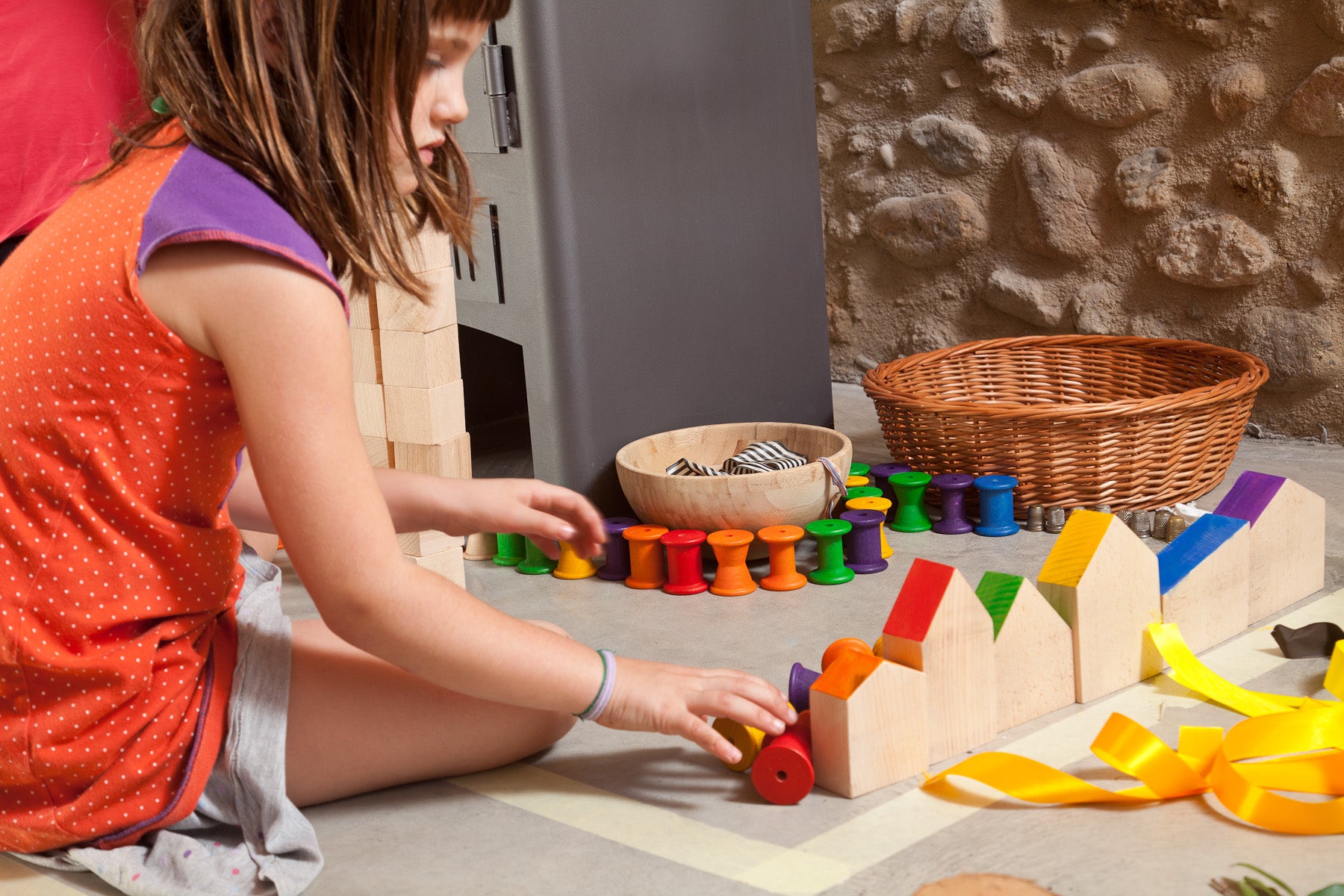
Autonomous gaming, why it's important and how to encourage it.
What is autonomous play?
It is the process by which a child engages in a certain activity alone, independently, without interaction with the caregiver or other children. For some parents cross, for others delight. In fact, some children are perfectly comfortable playing independently while others practically never do it! There are those who do it right away, those who develop this ability over time. There is no fixed rule or right or wrong and each child will have a different answer depending on their temperament, relationship with their parents and family lifestyle.
However, it is undeniable that the benefits of autonomous play are many. But don't despair, there are also many ways to stimulate it!
Benefits of independent gaming
1. Stimulate creativity and imagination
When a child interacts with an adult in play, it goes without saying that the impact of the adult will be strong, if not overwhelming at times. The adult will mediate many processes in interacting with their own ideas and beliefs. Although the educational value of an adult is of vital importance for a child, it is equally important that he spends time expressing his inner world and creativity in total freedom in a manner free from conditioning .
2. Helps social independence
It seems a paradox but learning to play alone also means learning to interact with the surrounding environment and the people who live there without the constant and reassuring presence of the caregiver.
3. Stimulates problem solving and self-confidence
Imagine a child struggling with a problem. Without the presence of the adult he will be forced to find his own solutions to solve the various dilemmas within the game. The child will soon learn to navigate problem solving on his own. This lays the foundations for building one's own sense of self-efficacy and for confidence in oneself and one's abilities.
4. Teach children to understand what they are good at and what interests them
Playing independently can provide the child with the freedom to experiment with various activities and find the one they want to explore. The presence of the parent is often penalizing, especially if the child enjoys activities that the parent does not approve of because he considers them inappropriate or dangerous.
5. It has a calming and self-regulating effect
Being able to play alone is a great way to build the foundation for staying calm and engaged, without the assistance of others. It is important to promote mechanisms by which the child learns to develop patience and emotional control.
6. It has obvious benefits for the parent
Do I need to explain? It goes without saying that, in addition to giving us that much needed time , seeing our child play independently gives us the great joy of knowing that he will get along very well even without our constant presence.

How to stimulate independent play
Parent expectations vs how many minutes of independent play a child should have
Due premise. I believe expectations are one of the most frustrating processes in our parenting journey. They are filtered by erroneous beliefs about how a child should "be" based on preconceptions and prejudices generally dictated by ignorance on education and pedagogy. We quickly start coming back to reality with the notion that an average child should be able to focus on an activity or task for approximately 2-5 minutes per year of age. We repeat like a mantra: 2-5 minutes for each year of age!
This means: at 1 year the concentration time is 2-5 minutes, at 2 years we are talking about 4-10 minutes, at 3 years 6-10 minutes, at 4 years 8-20 minutes at 5 years 10-25 minutes, and so on.
In addition, consider that if your child is not used to independent play, the time is further reduced.
Come to terms with boredom
Boredom is frustration. Especially in our current cultural context where we are bombarded with "entertainer" stimuli, boredom can seem like our worst enemy. Furthermore, a parent has a tendency to protect their child from uncomfortable or painful situations. Have you ever thought that if your newborn is trying to reach the ball using all the muscles of the body and you bring it closer to him, you are not helping him but lengthening the learning process?
Actually boredom is the bridge to creativity! she IS the forerunner of resilience and perseverance, fundamental skills that help us face life. If you've never encouraged independent play, you may end up with a whiny child who doesn't know what to do with himself. Try to see boredom as a gateway to a world where magic happens. Don't rush at the first complaint and if you really have to intervene, offer a choice or create an invitation to play.
Choose to offer appropriate toys and activities.
The space in which a child's play takes place is of essential importance. It is no coincidence that in the Reggio Emilia approach Loris Malaguzzi describes the learning space as a third educator (equally important to the educator and his classmates). Here are some tips for creating an inspiring space.
- If the idea is to encourage autonomous play, we certainly want to remove all those games that do not allow them to be "played" without adult input. In other words, if a game can't be played on its own, then it's no good! Sure, a little challenge is desirable but the child shouldn't go too far out of his comfort zone, otherwise he'll call the adult (rightly so). Rightly so, the space must also be "child-proof", i.e. safe for him, so that we adults can have the serenity of knowing that the child cannot slip or choke or bump.
- Organize the games well on special shelves, make sure they are immediately visible and graspable. A child still doesn't have the good ability to look for a game among many or to remember which box a certain game ended up in.
- Overcome your emotions of pure horror and allow the child to express himself freely by creating various messes. The game process is by definition "muddled". He'll clean up after that, peace! Don't place too many restrictions or rules. Full freedom is the keyword!
- Propose to your child materials that can stimulate the action schemes that he is currently exploring at that given moment.
- Choose a few but good games and practice the rotation of the games! It is about periodically changing the games that we make available by removing the others from view. This will have the effect of renewing the playground on a regular basis while keeping the interest always active.
- Offer materials without action limits, choose “open ended” games that are not related to a specific gender or age and that stimulate creativity by having a thousand ways to be played. Here are three game ideas that can be perfect for stimulating independent play:
- Create a invite to the game. It is about giving one or more stimuli to the child from which to start an activity or a game. The invitation to play can be particularly useful where you want to propose or reinforce some themes but above all for children who are approaching independent play for the first time and may have some difficulty in getting organised. For example, take a look at this insect-themed invitation. You can find modeling clays, rollers and molds in this collection.

- The space does not necessarily have to be separated or in another room. Yes they can be together but do different activities!
- Eliminate distractions. It goes without saying that screens should be turned off and the tranquility of this space respected.
Look at the spectacular space Dora has created for her little Matthew! Find here her beautiful Instagram profile of her dorandkingeorge .

Be present both physically and emotionally the rest of the time
Since Bowlby's studies on attachment theory back in 1969 we know that a child with a secure base will be much more inclined to explore the surrounding environment with initiative and serenity. We often wonder why our child can't have even five minutes of autonomy when it's us who can't really be 100% present even for five minutes in the space of a whole day. I read a beautiful sentence that went something like this: children don't need attention but connections.

Create a routine!
Children love routines and incorporating independent play into daily activities, even always around the same time, can be useful to make the child understand that that moment is dedicated to that activity (solo play). Creating a routine will also allow you to evaluate how things are evolving and to rejoice in the improvements!
I hope with this article I have given you some more ideas to stimulate independent play in your child! If you have any thoughts or questions, leave a comment below.
If you liked the article, leave a comment, save it or share it!



Visiterei con calma una città con mio marito, senza lo zaino dei giochi con me !
Dormirei una notte intera e mangerei una pizza calda e tutta in una volta 😂❤
Pomodorini A Merenda on
24h di libertà?? È realmente surreale
Sara on